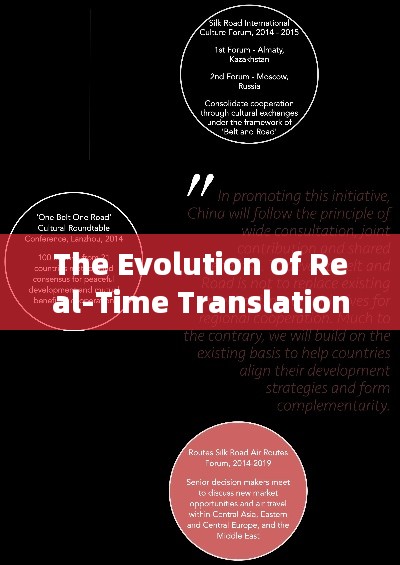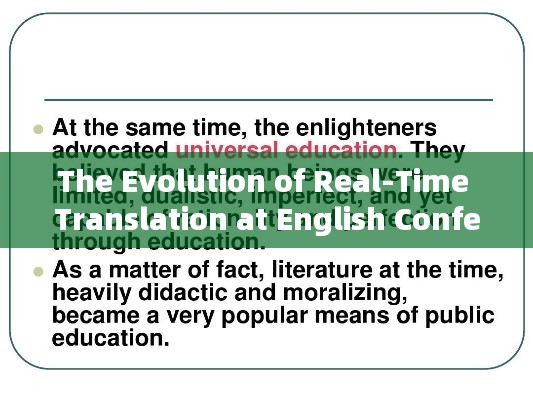The Evolution of Real-Time Translation at English Conferences
In the era of globalization, the importance of effective communication across language barriers cannot be overstated. English conferences, being a hub for international exchange of ideas, have always been at the forefront of adopting new technologies to facilitate cross-cultural discussions. One such technology that has revolutionized the way these conferences operate is real-time translation. This article delves into the evolution of real-time translation at English conferences, exploring its impact, challenges, and future prospects.
The Birth of Real-Time Translation
The Early Days
Real-time translation at English conferences was a nascent concept in the early 2000s. The first attempts at real-time translation were often clunky and limited to a few languages. However, the idea of breaking down language barriers was a game-changer. Conferences began to experiment with various technologies, including speech recognition, machine translation, and human interpreters working in tandem with technology.
The Rise of Machine Translation
Machine Translation's Ascendancy
As technology advanced, machine translation became more sophisticated. The introduction of cloud-based translation services like Google Translate and Microsoft Translator paved the way for real-time translation at conferences. These services could process and translate spoken words in real-time, albeit with varying degrees of accuracy. While the initial translations were often met with skepticism, the technology continued to improve, and conferences started to incorporate it into their programs.
The Role of Human Interpreters
Human Touch in Technology
Despite the advancements in machine translation, human interpreters remained an integral part of the real-time translation process. Interpreters could provide a level of nuance and context that machines often struggled to capture. Many conferences adopted a hybrid approach, where human interpreters worked alongside machine translation to ensure the accuracy and clarity of the translations.
Challenges and Limitations
Overcoming Technical Hurdles
Despite the progress made, real-time translation at English conferences faced several challenges. Technical issues such as poor internet connectivity, background noise, and the difficulty of translating certain accents and dialects often hindered the quality of the translations. Additionally, the cost of employing human interpreters and the complexity of integrating technology into existing conference setups remained significant barriers.
Language Limitations
Another challenge was the limited number of languages supported by real-time translation services. While English conferences often cater to a wide range of languages, not all languages had reliable translation services available. This limitation often meant that participants from certain linguistic backgrounds were left out of the conversation.
The Future of Real-Time Translation
Advancements in Technology
The future of real-time translation at English conferences looks promising. Advances in artificial intelligence and natural language processing are expected to further enhance the accuracy and reliability of machine translation. Additionally, the development of more sophisticated speech recognition technology will help overcome some of the technical hurdles that currently plague real-time translation.
Expanding Language Support
As the demand for real-time translation grows, service providers are increasingly focusing on expanding the number of languages supported. This expansion will not only make conferences more accessible to a broader audience but also foster a more inclusive and diverse global community.
Integration with Other Conference Technologies
Real-time translation is also expected to integrate more seamlessly with other conference technologies. This integration could include features like live captioning, sign language interpretation, and even real-time translation of visual content, making conferences more accessible to people with disabilities.
Conclusion
Real-time translation at English conferences has come a long way since its inception. While challenges remain, the continuous advancements in technology and the increasing demand for cross-cultural communication ensure that real-time translation will continue to evolve and improve. As the global community becomes more interconnected, the role of real-time translation in facilitating meaningful dialogue and exchange of ideas will only grow in importance.
The Evolution of Real-Time Voice Conference Translation
The Evolution and Challenges of Real-Time English Translation Evaluation
The Future of Communication: Real-Time Voice Conference Translation
The Evolution of Popular English Phrases in Everyday Life
Revolutionizing Productivity: The Power of RTCS in Modern Workplaces
Who Are the Hottest Heroes in the English Language?
The Evolution of English Pop Charts: A Deep Dive into the Most Popular Playlists
The Fruit of Hard Work: Unveiling the Rewards of Perseverance













 浙ICP备2021033100号-1
浙ICP备2021033100号-1